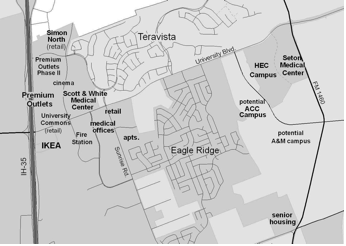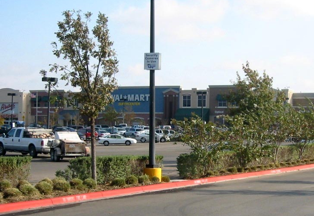Rock Beats
What’s New in Planning?
By Susan Brennan and Kerstin Harding
Over the past several years, the Planning and Community Development Department has seen many changes as staff has strived to keep pace with Round Rock’s rapid growth and development. By presenting a current snapshot of the department’s activities and responsibilities, we hope to provide you with some interesting information about the city’s future growth and expansion.
Long Range Planning Sets the Course for Future Development
About every ten years the Planning and Community Development Department updates the City’s General Plan. Simply put, the General Plan is the official policy document guiding development in Round Rock. It’s adopted by the City Council, and serves as the basis for the City Council’s decisions concerning zoning and land use. Zoning regulates the use of land. For example, whether a tract of land can be used for retail, office or an industrial use is dictated by the city’s zoning ordinances. All zoning recommendations must comply with General Plan policies.
Updating the General Plan is a collaborative effort that involves citizens, community groups, City Council and wide range of city departments. As our current General Plan was adopted in 1999, we expect to begin a comprehensive update soon. As part of this process, staff surveys the community and conducts citizen outreach meetings to gather input and comments that will help City Council determine the best land use policies for our growing city.
Annexation and Future Growth
Annexation is the process of incorporating new land into the city limits. Areas incorporated into the city receive city services (water, wastewater, police, fire, library, etc.) and are subject to city taxes and regulations. Annexation requires thoughtful analysis to ensure that utilities, streets, and police and fire services can be extended efficiently, and that the anticipated development on newly annexed areas will be consistent with the General Plan and compatible with neighboring properties.
There are a number of properties that the city has grown around that are included in our annexation program. By annexing these areas, the City will be in a position to exercise some limitations on land use. Areas outside the city limits have no restrictions on uses such as feed lots, junk car lots, or even heavy industrial uses that may be incompatible with adjacent neighborhoods. Having a program to proactively negotiate annexation with property owners helps prevent incompatible uses from becoming established in the first place.
Currently, staff is focusing its annexation program on northeast Round Rock. City Council has expressed its desire to annex properties in the northeast in order to manage land use along University Boulevard and, ultimately, along SH-130.
The Northeast
The Round Rock Premium Outlets, IKEA, the HEC campus building, and Scott & White Hospital are only the beginnings of new development in northeast Round Rock. The HEC will become a full-fledged university campus with student services and housing. Seton is in the process of expanding its hospital campus next to the HEC campus. In addition, Austin Community College and Texas A&M University have indicated their interest in locating south of University Boulevard and west of FM 1460. The Planning Department is working with landowners in the area to master plan this future employment, commercial, entertainment and residential center in order to take advantage of potential synergies that can be created with this new development.
Major developments in the northeast
Development Review Committee
With the adoption of the newest Zoning Ordinance in 2002, City Council established the Development Review Committee (DRC). The DRC is an interdepartmental site plan review team that evaluates development proposals with respect to zoning and landscaping requirements, utility capacity and specific health/safety requirements such as fire access. By using a team approach in reviewing site plans, the DRC can ensure efficiency and accuracy when reviewing new development proposals.
The DRC is chaired by Brad Wiseman (Planning), and its members include Taylor Horton and Amy Swaim (Planning), Alysha Girard, Aneil Naik and Sana Mohtashami (Engineering & Development Services), Mark Remmert (Building Inspection), Emsud Horozovic and Jim Carse (Forestry), Billy Wusterhausen and Mark Selby (Fire), Terrell Wilkey (Utilities) and John Dean (Transportation).
Better Design Standards
The DRC reviews proposals using design standards that are outlined in the Zoning Ordinance. These standards include, among others, the type of building materials that can be used in a particular zoning district, the amount and type of landscaping required on a specific tract of land along with standards regulating the screening of outdoor storage, trash receptacles and loading areas. Prior to the 2002 Zoning Ordinance revisions, the city’s zoning regulations contained few design requirements. The following photos illustrate how our improved design standards have made a substantial impact on community appearance.
Commercial building before increased landscaping and design standards
Commercial building with increased landscaping and design standards
Community Development in Action
Mona Ryan and Margie Lopez staff the city’s Office of Community Development.
The Office of Community Development is funded by the US Department of Housing and Urban Development (HUD), and implements programs and activities that address the needs of low and moderate income residents in Round Rock by using Community Development Block Grant (CDBG) funds as well as other City and federal resources. Approximately sixty-five percent of CDBG funds are used in housing activities, such as and single family owner occupied housing rehabilitation.
Public services are also funded through the block grant program. These include youth services through PARD and the Round Rock Serving Center, elderly services through the Round Rock Housing Authority and Catholic Charities, and nutrition services through the Baca Center. While many of these programs directly benefit individuals and families, the entire community benefits through Community Development’s investment in the health, safety and stability of Round Rock’s neighborhoods.
Code Enforcement on the Street
You’ve probably seen Code Enforcement Officers, Rick Clark, Rex Richardson and Angel Martinez out gathering illegal “bandit” signs along city streets. Their work doesn’t stop there, however. Each day our officers respond to citizen calls concerning problems with weedy lots, junk vehicles, and numerous other zoning code violations which present health and safety problems. Margie Lopez fields telephone calls and questions in the office, and then dispatches our officers so they can investigate code violations and also address citizen concerns.
For more information, visit the Planning home page at roundrocktexas.gov



